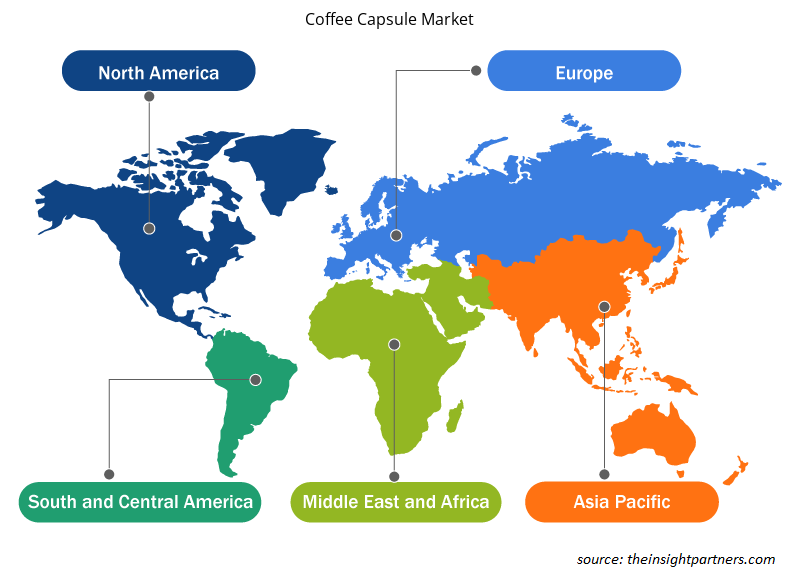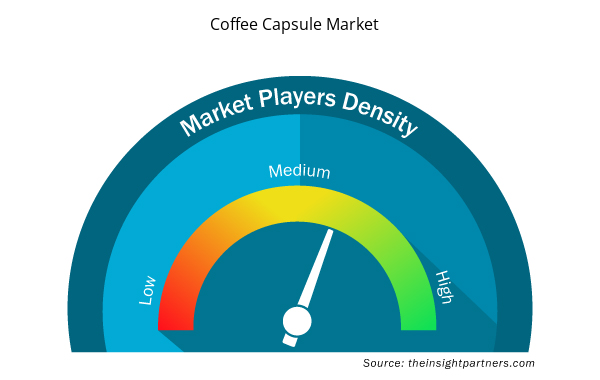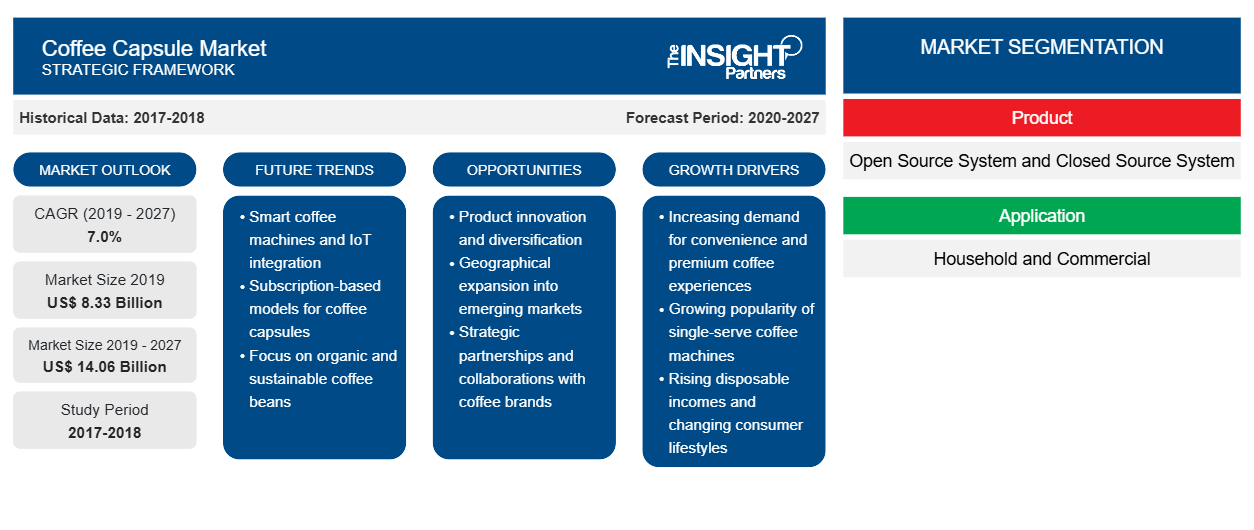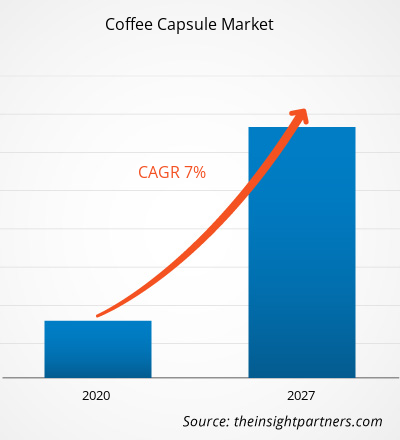[研究报告] 2019 年咖啡胶囊市场价值为 83.2719 亿美元,预计到 2027 年将达到 140.622 亿美元;预计在 2020-2027 年预测期内复合年增长率为 7.0%。
咖啡胶囊是指用塑料或铝包装代替纸质滤纸包装的咖啡。它通常设计用于单个品牌或系统,不能与其他系统互换。咖啡胶囊是一种单份真空包装的胶囊,需要与之兼容的机器。注重健康的消费者对咖啡产品的消费量正在上升;因此,制造商计划在市场上开发新的创新配方,如咖啡胶囊、无糖咖啡预混料和其他产品。阿尔茨海默病是老年人痴呆的主要原因,其次是帕金森病。研究表明,每天喝三到五杯咖啡可以将患阿尔茨海默病、帕金森病和其他形式痴呆症的风险降低高达 65%。抗氧化剂可以对抗体内损害健康的自由基(“氧化剂”)并增强免疫系统。许多水果和蔬菜也能对抗氧化剂,但咖啡是消费者中最受欢迎的饮料,因为它是抗氧化剂的丰富来源。咖啡有助于降低患多种癌症的几率,包括口腔癌、皮肤癌和肝癌。II 型糖尿病是一种潜在的致命疾病,在澳大利亚已达到流行病的程度。许多研究表明,咖啡可以大大降低患糖尿病的风险。咖啡因通过两种方式提高运动成绩。它提高新陈代谢,增加脂肪酸的氧化,并调动脂肪组织中的脂肪酸。由于咖啡具有抗癌特性,注重健康的消费者对咖啡的消费量有所增加。饮用咖啡的这些好处推动了全球对咖啡胶囊的需求。
预计在预测期内,欧洲将占据全球咖啡胶囊市场的最大份额。这主要归因于消费者饮食习惯和社会经济条件的转变。消费者可支配收入的增加和咖啡消费者数量的增加推动了咖啡胶囊市场的发展。营养和健康产品支出的增加以及对咖啡胶囊健康益处的认识不断提高也支持了该地区的市场。便利性、品牌体验、高端定位以及制造商创新和提供新产品的能力的结合是另一个有利于欧洲咖啡胶囊市场的因素。此外,消费者偏好从速溶咖啡转向更高端的选择,例如新鲜研磨咖啡,预计将推动该地区的咖啡胶囊市场的发展。此外,欧洲各国特色咖啡馆的日益普及进一步推动了咖啡的消费,从而进一步支持了咖啡胶囊市场。
COVID-19 疫情于 2019 年 12 月在中国武汉爆发,并迅速蔓延至全球。截至 2020 年 9 月,美国、印度、巴西、俄罗斯、西班牙、墨西哥和阿根廷是 COVID-19 病例和死亡人数最多的国家。根据世卫组织的报告,截至 9 月,全球 COVID-19 确诊病例约 33,580,503 例,死亡病例约 1,006,975 例。由于实施封锁、旅行禁令和企业停工,COVID-19 疫情影响了经济和企业。全球食品和饮料行业是因封锁和办公室关闭而导致供应链中断和制造中断的主要行业之一。所有这些因素都极大地影响了全球咖啡胶囊市场的增长。
定制此报告以满足您的需求
您可以免费定制任何报告,包括本报告的部分内容、国家级分析、Excel 数据包,以及为初创企业和大学提供优惠和折扣
- 获取此报告的关键市场趋势。这个免费样品将包括数据分析,从市场趋势到估计和预测。
市场洞察
以便利为导向的客户风格
消费者倾向于使用创新机器以方便使用,这增加了全球胶囊咖啡机的采用,进而推动了市场的增长。由于人口不断增长和西方潮流的日益普及,中国和印度是咖啡包和胶囊的潜在市场。如今,由于城市化,消费者的生活方式以工作为导向。他们需要一切快速便捷。他们寻找可以节省成本并提供良好质量的产品;因此,咖啡胶囊的需求量很大。即饮咖啡饮料需求的增加主要推动了亚太地区的市场发展。由于时间紧迫的消费者的需求不断增加,咖啡店使用这些产品的情况有所增加。胶囊机技术不断进步,具有新功能、创新概念和应用,可提供更高的质量和更大的容量,同时降低能耗和降低维护成本。许多发展中经济体的快速城市化、基础设施发展和劳动人口的增加增加了对方便使用的包装食品和饮料的需求。因此,大多数咖啡馆和餐馆对咖啡胶囊的采用正在增加。
产品洞察
根据产品,咖啡胶囊市场进一步分为开源系统和闭源系统。2019 年,闭源系统部分占据了市场主导地位。在胶囊咖啡系统中,咖啡被收缩包装在胶囊中而不是滤纸中。胶囊和豆荚种类繁多,咖啡含量为 7-10 克。咖啡胶囊用于一系列产品,而不仅仅是研磨咖啡。闭源系统是特定机器与特定胶囊的组合。闭源系统是第一个进入市场的系统,因此,该部分占全球胶囊咖啡机市场的较大份额。咖啡胶囊机有很多优点。它简化了咖啡制作过程,省去了研磨、压榨和储存咖啡的步骤。胶囊中的咖啡被研磨至完美,并在最佳压力下密封。因此,所有这些因素都推动了对咖啡胶囊的需求。此外,年轻人口的增长和咖啡店数量的增加预计将进一步推动市场对咖啡胶囊的需求。
应用程序洞察
根据应用,咖啡胶囊市场进一步细分为家庭和商业。2019 年,商业部门占据了市场主导地位。咖啡消费量的增加是推动咖啡胶囊需求的重要因素之一。千禧一代在咖啡店社交的日益流行,也促进了特色咖啡店的日益普及。对不同新鲜咖啡类型的偏好进一步导致了咖啡店、特色咖啡店和快餐店的出现。此外,发达经济体和新兴经济体的咖啡消费量都在大幅增加。在发达国家,咖啡是仅次于软饮料的第二大首选饮料。咖啡需求的不断增长为市场中的供应商创造了有利可图的机会,进而推动了预测期内特色咖啡店市场的增长。由于咖啡店文化的迅速发展,预测期内,现磨咖啡豆和咖啡胶囊的数量和价值都将大幅增长。
分销渠道洞察
根据分销渠道,咖啡胶囊市场进一步细分为超市和大卖场、专卖店、网上商店等。2019 年,超市和大卖场占据了市场主导地位。超市和大卖场提供各种各样的食品、饮料和家用产品。超市和大卖场提供广泛的商品组合以及不同品牌的咖啡胶囊,并放在同一屋檐下。咖啡胶囊在超市和大卖场有专门的区域;因此,为客户提供了多种选择。生产商直接将咖啡胶囊卖给经销商或分销商,经销商或分销商再将其卖给超市和大卖场的分销商。超市和大卖场的分销商根据消费者的需求保存咖啡胶囊的种类。大卖场和超市的客流量大,使咖啡胶囊生产商更容易瞄准他们的客户群。
全球咖啡胶囊市场的一些主要参与者包括 VERO Coffee、Vittoria Food and Beverage、Belmoca Belgium(Belmio)、Coind group、Nestle Nespresso SA、Jacobs Douwe Egberts BV、Gloria Jean's Gourmet Coffee、Luigi Lavazza SpA、Dualit Limited 和 illycaffè SpA。这些公司实施新产品开发、并购战略,以扩大客户群并在全球范围内获得显著的市场份额,从而使参与者能够在全球市场上保持其品牌名称。
咖啡胶囊市场区域洞察
Insight Partners 的分析师已详细解释了预测期内影响咖啡胶囊市场的区域趋势和因素。本节还讨论了北美、欧洲、亚太地区、中东和非洲以及南美和中美洲的咖啡胶囊市场细分和地理位置。

- 获取咖啡胶囊市场的区域特定数据
咖啡胶囊市场报告范围
| 报告属性 | 细节 |
|---|---|
| 2019 年市场规模 | 83.3亿美元 |
| 2027 年市场规模 | 140.6亿美元 |
| 全球复合年增长率(2019 - 2027) | 7.0% |
| 史料 | 2017-2018 |
| 预测期 | 2020-2027 |
| 涵盖的领域 | 按产品
|
| 覆盖地区和国家 | 北美
|
| 市场领导者和主要公司简介 |
|
咖啡胶囊市场参与者密度:了解其对业务动态的影响
咖啡胶囊市场正在快速增长,这得益于终端用户需求的不断增长,而这些需求又源于消费者偏好的不断变化、技术进步以及对产品优势的认识不断提高等因素。随着需求的增加,企业正在扩大其产品范围,进行创新以满足消费者的需求,并利用新兴趋势,从而进一步推动市场增长。
市场参与者密度是指在特定市场或行业内运营的企业或公司的分布情况。它表明在给定市场空间中,相对于其规模或总市场价值,有多少竞争对手(市场参与者)存在。
在咖啡胶囊市场运营的主要公司有:
- 格洛丽亚·吉恩
免责声明:上面列出的公司没有按照任何特定顺序排列。

- 获取咖啡胶囊市场顶级关键参与者概述
咖啡胶囊市场,按产品类型划分
- 开源系统
- 闭源系统
咖啡胶囊市场(按应用划分)
- 家庭
- 商业的
咖啡胶囊市场,按分销渠道划分
- 超市和大卖场
- 专卖店
- 在线商店
- 其他的
公司简介
- VERO 咖啡
- Vittoria 食品和饮料
- 比利时贝尔莫卡 (Belmio)
- 科因德集团
- 雀巢 Nespresso 公司
- Jacobs Douwe Egberts BV
- Gloria Jean 的美食咖啡
- 路易吉·拉瓦扎有限公司
- 雙重有限公司
- 意利咖啡有限公司
- 历史分析(2 年)、基准年、预测(7 年)及复合年增长率
- PEST 和 SWOT 分析
- 市场规模价值/数量 - 全球、区域、国家
- 行业和竞争格局
- Excel 数据集


- Quantitative Structure-Activity Relationship (QSAR) Market
- Mobile Phone Insurance Market
- Collagen Peptides Market
- Constipation Treatment Market
- Customer Care BPO Market
- Fill Finish Manufacturing Market
- Drain Cleaning Equipment Market
- Bioremediation Technology and Services Market
- Biopharmaceutical Tubing Market
- Medical Audiometer Devices Market

Report Coverage
Revenue forecast, Company Analysis, Industry landscape, Growth factors, and Trends

Segment Covered
This text is related
to segments covered.

Regional Scope
North America, Europe, Asia Pacific, Middle East & Africa, South & Central America

Country Scope
This text is related
to country scope.
常见问题
Closed source system held the largest share in the global coffee capsule market in 2019. The closed source system refers to a combination of a particular machine with a specific capsule. As the closed source system was, first to be introduced in the market, they are used in many coffee machines and hence accounts for a larger share in the coffee capsule market.
The major players operating in the global coffee capsule market are Coffee Capsule market include VERO Coffee, Vittoria Food and Beverage, Belmoca Belgium (Belmio), Coind group, Nestle Nespresso S.A, Coind Group, Jacobs Douwe Egberts BV, Gloria Jean’s Gourmet Coffee, Luigi Lavazza S.p.A, Dualit Limited and illycaffè S.p.A. among many others.
In 2019, Europe held the largest share of the global coffee capsule market. The demand for coffee capsule is expected to increase in the region due to the transforming lifestyles and rise in disposable income available in the hands of the consumers. The rise in awareness about the high antioxidant activity and chemical composition associated with coffee capsule drives the market for coffee capsule all across European countries.
Trends and growth analysis reports related to Food and Beverages : READ MORE..
The List of Companies - Coffee Capsule Market
- Gloria Jean’s Gourmet Coffee
- Jacobs Douwe Egberts BV
- Nestlé Nespresso S.A.,
- Luigi Lavazza S.p.A
- illycaffè S.p.A.
- VERO Coffee
- Belmio
- Vittoria Food & Beverage
- Coind Group
- Dualit Limited
The Insight Partners performs research in 4 major stages: Data Collection & Secondary Research, Primary Research, Data Analysis and Data Triangulation & Final Review.
- Data Collection and Secondary Research:
As a market research and consulting firm operating from a decade, we have published and advised several client across the globe. First step for any study will start with an assessment of currently available data and insights from existing reports. Further, historical and current market information is collected from Investor Presentations, Annual Reports, SEC Filings, etc., and other information related to company’s performance and market positioning are gathered from Paid Databases (Factiva, Hoovers, and Reuters) and various other publications available in public domain.
Several associations trade associates, technical forums, institutes, societies and organization are accessed to gain technical as well as market related insights through their publications such as research papers, blogs and press releases related to the studies are referred to get cues about the market. Further, white papers, journals, magazines, and other news articles published in last 3 years are scrutinized and analyzed to understand the current market trends.
- Primary Research:
The primarily interview analysis comprise of data obtained from industry participants interview and answers to survey questions gathered by in-house primary team.
For primary research, interviews are conducted with industry experts/CEOs/Marketing Managers/VPs/Subject Matter Experts from both demand and supply side to get a 360-degree view of the market. The primary team conducts several interviews based on the complexity of the markets to understand the various market trends and dynamics which makes research more credible and precise.
A typical research interview fulfils the following functions:
- Provides first-hand information on the market size, market trends, growth trends, competitive landscape, and outlook
- Validates and strengthens in-house secondary research findings
- Develops the analysis team’s expertise and market understanding
Primary research involves email interactions and telephone interviews for each market, category, segment, and sub-segment across geographies. The participants who typically take part in such a process include, but are not limited to:
- Industry participants: VPs, business development managers, market intelligence managers and national sales managers
- Outside experts: Valuation experts, research analysts and key opinion leaders specializing in the electronics and semiconductor industry.
Below is the breakup of our primary respondents by company, designation, and region:

Once we receive the confirmation from primary research sources or primary respondents, we finalize the base year market estimation and forecast the data as per the macroeconomic and microeconomic factors assessed during data collection.
- Data Analysis:
Once data is validated through both secondary as well as primary respondents, we finalize the market estimations by hypothesis formulation and factor analysis at regional and country level.
- Macro-Economic Factor Analysis:
We analyse macroeconomic indicators such the gross domestic product (GDP), increase in the demand for goods and services across industries, technological advancement, regional economic growth, governmental policies, the influence of COVID-19, PEST analysis, and other aspects. This analysis aids in setting benchmarks for various nations/regions and approximating market splits. Additionally, the general trend of the aforementioned components aid in determining the market's development possibilities.
- Country Level Data:
Various factors that are especially aligned to the country are taken into account to determine the market size for a certain area and country, including the presence of vendors, such as headquarters and offices, the country's GDP, demand patterns, and industry growth. To comprehend the market dynamics for the nation, a number of growth variables, inhibitors, application areas, and current market trends are researched. The aforementioned elements aid in determining the country's overall market's growth potential.
- Company Profile:
The “Table of Contents” is formulated by listing and analyzing more than 25 - 30 companies operating in the market ecosystem across geographies. However, we profile only 10 companies as a standard practice in our syndicate reports. These 10 companies comprise leading, emerging, and regional players. Nonetheless, our analysis is not restricted to the 10 listed companies, we also analyze other companies present in the market to develop a holistic view and understand the prevailing trends. The “Company Profiles” section in the report covers key facts, business description, products & services, financial information, SWOT analysis, and key developments. The financial information presented is extracted from the annual reports and official documents of the publicly listed companies. Upon collecting the information for the sections of respective companies, we verify them via various primary sources and then compile the data in respective company profiles. The company level information helps us in deriving the base number as well as in forecasting the market size.
- Developing Base Number:
Aggregation of sales statistics (2020-2022) and macro-economic factor, and other secondary and primary research insights are utilized to arrive at base number and related market shares for 2022. The data gaps are identified in this step and relevant market data is analyzed, collected from paid primary interviews or databases. On finalizing the base year market size, forecasts are developed on the basis of macro-economic, industry and market growth factors and company level analysis.
- Data Triangulation and Final Review:
The market findings and base year market size calculations are validated from supply as well as demand side. Demand side validations are based on macro-economic factor analysis and benchmarks for respective regions and countries. In case of supply side validations, revenues of major companies are estimated (in case not available) based on industry benchmark, approximate number of employees, product portfolio, and primary interviews revenues are gathered. Further revenue from target product/service segment is assessed to avoid overshooting of market statistics. In case of heavy deviations between supply and demand side values, all thes steps are repeated to achieve synchronization.
We follow an iterative model, wherein we share our research findings with Subject Matter Experts (SME’s) and Key Opinion Leaders (KOLs) until consensus view of the market is not formulated – this model negates any drastic deviation in the opinions of experts. Only validated and universally acceptable research findings are quoted in our reports.
We have important check points that we use to validate our research findings – which we call – data triangulation, where we validate the information, we generate from secondary sources with primary interviews and then we re-validate with our internal data bases and Subject matter experts. This comprehensive model enables us to deliver high quality, reliable data in shortest possible time.


 获取此报告的免费样本
获取此报告的免费样本